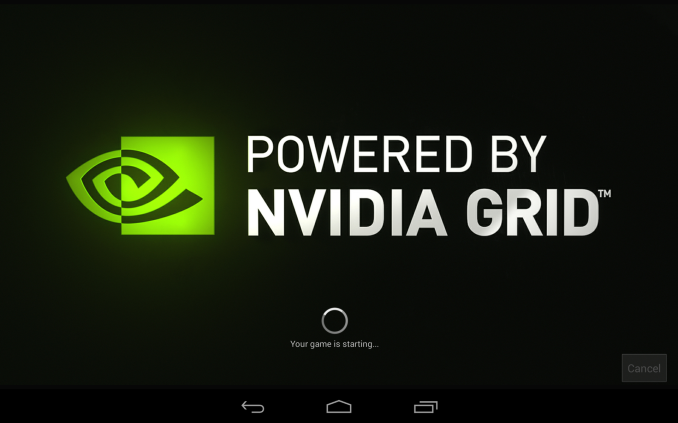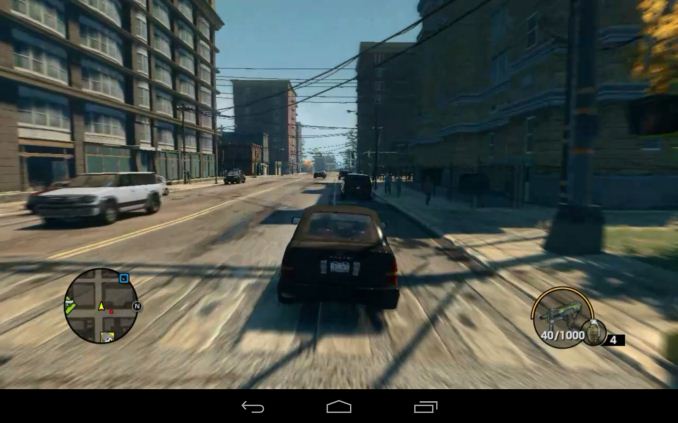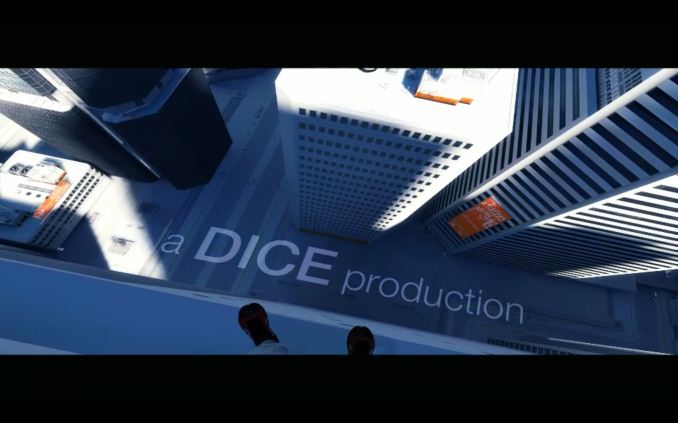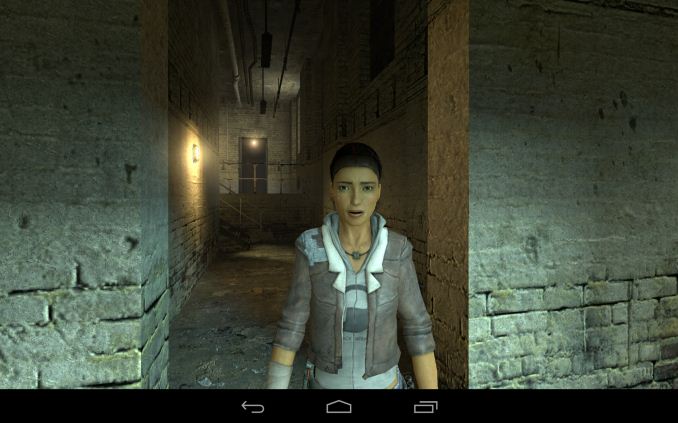The NVIDIA SHIELD Tablet Review
by Joshua Ho on July 29, 2014 9:00 AM ESTGameStream and GRID
The final software features that Shield Tablet brings to the table are GameStream and GRID. These are effectively methods of turning the tablet into a thin client, as all of the rendering/computation is done on a computer either in the LAN or on a server in San Jose. From a technical perspective, both work great as long as the connection has high bandwidth and low latency. For GRID, I managed to get a great user experience on a symmetrical 10 Mbps connection and around 10ms latency to the server. Games like Saints Row 3 played as if running on a console when the device is actually streaming from NVIDIA servers. From the user’s perspective, it’s a matter of going into the app drawer, opening GRID, and selecting a game. It’s simple and given sufficient server coverage I could easily see a Netflix-style usage model taking off quite successfully.
Although I didn’t spend as much time with GameStream, I didn’t detect any input lag and for the most part it’s just as simple. As long as a GameStream-enabled PC is on the same network, accessing GameStream compatible games is just a matter of going to the Shield Hub application, entering a four digit code on the PC to pair it with the tablet, and selecting a game. GameStream also works remotely, but the same caveats that come with GRID apply to GameStream on both the server and client end. Of course, the games that will run on GameStream have to be carefully selected. While it’s fully possible to play a twitch shooter like Call of Duty through GameStream, trying to use a controller in multiplayer is simply a massive disadvantage against people that are competent with a mouse and keyboard. I've included a screenshot of Mirror's Edge that I took while testing GameStream.
Gaming Ecosystem
Ultimately, I’m a bit conflicted on whether GameStream and GRID are really designed to stand on their own though. GameStream only works while you’re at home, and GRID is highly dependent upon low latency and also needs around 10 Mbps download and 5 Mbps upload for an ideal experience. Due to the latency requirement and the fact that the only GRID server bank is in San Jose, the very low latencies that GRID is best suited for are generally only achievable in California and parts of other nearby states. They’re definitely great in the situations that they work, but ultimately the native game library has to stand alone. To this end, the tablet is in a far better situation than the original Shield. The number of games that provide a quality gaming experience is now leaps and bounds better than what we saw with the launch of the Shield Portable. Trine 2 is included out of the box, and while I didn’t get a chance to try co-op mode it’s a compelling experience that once needed GameStream or GRID to be played on Shield. Along the same lines, the Grand Theft Auto series, Half Life 2, and Portal all play surprisingly well.
Fundamentally though, I don’t think single player games alone will sell Shield as a gaming platform. A single player game can only have a certain amount of replay value. Something like Half Life 2 might have 12 hours of gameplay at best. In comparison, multiplayer has massive amounts of replay value because even the same map can play out differently depending upon the people that play in the round. It’s that factor that makes it possible for people to spend 1200 hours playing a game like Battlefield 2. Unfortunately, for the most part the Shield tablet has a game library that seems to be skewed towards single player games. Fortunately, NVIDIA seems to understand this. While I haven’t been able to play War Thunder on Shield tablet, the promise of compelling multiplayer games on this device would be a strong enough reason to excuse potential shortcomings in other areas. Although it's good that an immersive multiplayer title is coming to Shield tablet, the key point of emphasis is that people playing a Shield device can play with those on console or PC as well. Until NVIDIA hits critical mass for Shield device adoption, multiplayer titles that only allow people on Shield to play with others on Shield will struggle because people won't play multiplayer unless there are other people to play with.















174 Comments
View All Comments
Wolfpup - Tuesday, July 29, 2014 - link
Wish it had a larger screen. I'd really love a 12" screen for graphic novels and magazines, but I at least want 10".Regarding Half-Life...it's awesome it runs on this, but super lame it I guess REQUIRES Nvidia hardware to run? Android's already a big enough mess as it is. I don't need programs that only run on some and not all Android devices.
Wolfpup - Tuesday, July 29, 2014 - link
I wonder about the controller too...it seems very nice, but wondering if it'll work with PC games or iOS for that matter.vision33r - Tuesday, July 29, 2014 - link
Those of us that owned the 1st gen Shield love it because of the portability and form factor. I am able to use it on the train or plane easily like a NDS. This thing now requires that I put it on the dock or stand.I think they would be better off releasing a Shield with 5.7" display edge to edge instead of the big border.
I can play most games like Skyrim on a 5" display well just annoyed by the border.
chizow - Tuesday, July 29, 2014 - link
If you listen to the MaxPC webcast with Tom Petersen, I think there is a very good chance we see an updated Shield Portable 2. Not sure about a bigger screen, I'd get one too if it had a 6" 1080p screen and TK1, but there's a good chance it has its SoC updated. I am 99% sure Nvidia said TK1 is pin compatible with T4, so it would be an easy upgrade.TheJian - Wednesday, July 30, 2014 - link
Agreed, shield r2 is coming. They have said recently they serve different markets (and they do). There was no mention of it not being revved yearly and specs are out for 4GB, 1440x810 etc. That is no where near this device and seems likely a perfect update to Shield 1 and more geared towards handheld hardcore gamers. Shield was only 10mil to develop, so plopping in K1 shouldn't be much more if they stick with the same design etc, just amp a few things up (memory etc). No need for a massive redesign it was already good. Sticking with 720p or just above should save on power also, again more in line with a handheld usage playing games. MHL 3.0, usb 3.0 and support for a large SD card is all I'd need to jump I think.They said K1 32 and 64 Denver K1 is pin compatible, but not T4. But that's not a huge redesign considering the whole thing only cost 10mil the first time. They only needed to sell about 100K-150K to break even probably (assuming $100 or so profits for each sold based on ~160 vita cost, and 101 for 3ds BOM at launch for them). Everything from Vita/3ds got shrunk so costs are probably similar.
GC2:CS - Tuesday, July 29, 2014 - link
When nvidia had showed its prototype Kepler mobile GPU for the first time for examination here on anadtech I was excited as it showed it was drastically more efficient and faster than the king of mobile GPU's at that time the A6X. It just kind of blew it away, even though Apple really gone wild when talking about SoC's: a custom CPU architecture, a GiGantic GPU, huge amounts of bandwidth etc. But with such Kepler GPU they could afford to wait for a year and still beat everyone at least in theory.But in reality ? A year after Kepler prototype, we have well.... two tablets and an all in one ? And after a year even the power and performance story doesn't look as good as interpreted by nvidia.
After a year we got the new Apple A7 that nVidia claimed about that their new K1 is 3x faster and 50 % more efficient.
Lets compare them now.
A7 gets 13 fps in manhattan and K1 over 30 fps, but still well short of 3x which is.13by3...wait...... about 39 fps. So about 2,4 times faster in comparison, still nice.
Then there is efficiency. Running down a 19.75 battery in 2.2 hours with a display that consumes AT MOST 1,46 W at 200 nits yields an power consumption of all other components of AT LEAST 7,3W (most of that is the SoC+RAM) which is downright ridiculous. Then there is throttling. Maybe it doesn't look significant on that chart, but it reached vsync in first dozen runs. Taking into consideration off screen tests, without vsync it would run at about 63,5 at native resolution and it would start throttling sooner. Now going down to 46,1 thats a difference of 27%. Still nice for so many runs, but not all tablets have dedicated magnesium heat spreader installed in them and I don't think it will be problem for a gamer to play a PC game port for 70 minutes or more non-stop. But the bad thing is that it throttles even with that heat spreader, and that means its really hot.
And now lets compare with A7. Its got far far lower power compustion under full load and also generates far less heat, so it the GPU doesn't throttle at all. Taking this into consideration, the tegra can be less than 2,4 x the A7, especially in tablets without custom heat spreaders and after prolonged use. And ouch a phone ! You can put the A7 into a phone ! And the GPU doesn't throttle at all as well. And then the A7 is 10 months old chip and still tegra has a hard time even in terms of efficiency. The A8 will be entirely different league, it will crush tegra, not it performance, but in efficiency.
Considering all of this it just kind of dissapoints me.
identity - Tuesday, July 29, 2014 - link
iSheep trying to spread that Apple propaganda lol! Nice try though :)melgross - Tuesday, July 29, 2014 - link
The fact that you feel the need to use that word just shows that your thinking is very limited. If you have something useful to say, try to refute what he said instead. Stop acting as though you're 12 years old.ams23 - Tuesday, July 29, 2014 - link
Mobile Kepler in Tegra K1 is roughly 50% more power efficient than G6430 in A7 with GFXBench 3.0 Manhattan Offscreen test: http://images.anandtech.com/doci/7622/Screen%20Sho...Regarding throttling, there is virtually no throttling on Shield tablet until after 115 (!) runs: http://images.anandtech.com/doci/8296/TRexRunDownG... . You can see that Onscreen fps only varies by a couple fps during that time.
As for battery life, Shield tablet has a battery saver mode which should result in superior battery life for gaming.
At the end of the day, mobile Kepler can reach performance levels and playable settings that other thin fanless tablets currently on the market cannot even hope to reach. I would much rather have 3 hours of smooth and playable gameplay at 30-60fps than 5 hours of non-playable gameplay at 15-25fps.
melgross - Tuesday, July 29, 2014 - link
That's very true. But this is a new chip, and the A7 is now becoming an old chip, by the standards of mobile development. It will be interesting to see whether Apple can improve the A8 by the amounts they've been doing the past generations. Rumor has it that it will again be a 2 core design. If so, it could lead to some interesting strategies on the part of Apple.But, like anything else, we'll have to wait.